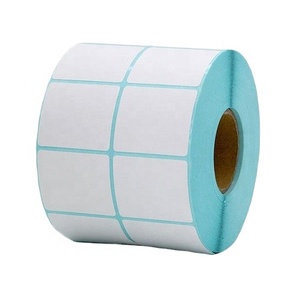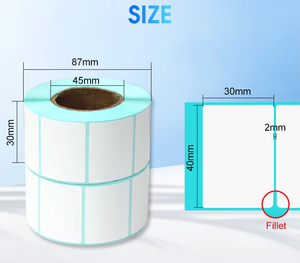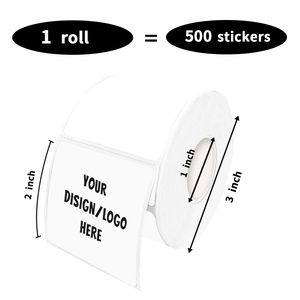
All categories
Featured selections
Trade Assurance
Buyer Central
Help Center
Get the app
Become a supplier

(18295 products available)















































Thermal barcode label rolls are important for several industries, including shipping, retail, and inventory management, particularly in situations that require a lot of labelling. To fulfil different needs, thus, these labels are available in various types. There are two main thermal printing systems that thermal labels for bar codes exist: direct thermal and thermal transfer. Below are the types of thermal barcode label rolls.
Those that use direct thermal printing make up a large portion of the barcode label rolls. These labels are produced by applying heat to the thermal-sensitive paper. The result is a label that shows a barcode using a printer. This kind of label is always preferred because of its simple and cost-effective nature.
Direct thermal label rolls are often used in temporary applications like shipping labels, stickers, and labels that identify drugs or packages to avoid the need for permanent labels. Direct thermal labels, however, fade over time and hence not recommended for products that need long-term labelling or outdoor use.
As opposed to direct thermal labels, thermal transfer labels make use of thermal printing ribbons in conjunction with thermal-sensitive materials. These labels feature heat-resistant ribbons that are melted onto the label's surface with the help of a thermal print head to create long-lasting images.
In cases where high durability is needed, such as labels for industrial applications, or barcodes that need to be scanned frequently, thermal transfer label rolls are suitable. It also offers a diversity in label materials, including plastic, polyester, and vinyl. These materials increase the labels' resistance to abrasion, moisture, and fading.
Selecting the correct type of thermal label roll is based mainly on the desired labelling application, environment, and permanence. Both of these types have unique advantages depending on their requirements.
A variety of parameters are incorporated into the thermal barcode label rolls to go with the needs of the labelling systems in place. The design of these labels affects their efficiency, readability, and printers' compatibility. Below are the constituents of the design of thermal barcode label rolls.
Thermal label materials vary widely, from robust vinyl and polyester to temporary paper stock. Each material has properties that suit particular environments, such as exposure to moisture or chemicals. Label sizes also differ based on the space available on the package or product, as well as the content that needs to be displayed. Before purchasing, labelling needs must be measured to make sure suitable materials and sizes are selected effectively.
The type of adhesive used on thermal barcode label rolls is very essential, especially in various environments and application surfaces. Some common varieties include the standard permanent, removable, and special for low-energy or refrigerated surfaces. Cold temperature, for instance, affects the adhesion of the labels. Therefore, selecting the correct adhesive contributes to the efficiency of the labelling system.
In some cases, customers might need labels that have specific designs or even differ in size from the regularly used sizes. Such custom shapes might include barcode placements, text, graphics, or pre-cut labels for dispensers. Where appropriate, custom labels are also designed using a template that ensures the barcodes have measurements that are commonly scanned.
A lot of factors come into play when deciding the correct thermal barcode label rolls of printers. To improve the efficiency of the labeling system, one must take into consideration size, material, and label type. For one, the size of a label must be compatible with a printer and the space available on a product or package. These can range from small labels for tiny containers and packages to large labels for heavier items of all dimensions. In this case, one needs to work on the printer first and ensure that the sizes required by the thermal barcode label rolls correspond to the available space on the printer.
The material is another crucial part since these labels must be compatible with certain environments in which they exist. Paper labels are suitable for temporary applications such as shipment and storage; however, materials such as vinyl and laminate may provide moisture and chemical protection for long-term labelling. Apart from this, the type of adhesive used on these materials is also important in making the labels stick to different surfaces. There are several types of adhesives that can be used: permanent, which is used for most surfaces; removable, which is used for temporary use; and special formulations for low-energy surfaces.
Labels can also be created using customised shapes, which can include such features as perforation, specific die cuts, and graphics or text. In some cases, labels with barcodes that need to be the right size for efficient scanning can be especially helpful. So, the selection of labels that are optimally unique to their clients' needs will boost the efficiency of their labelling systems' success rates.
In conclusion, considering the size of the label, the material it will be constructed out of, the compatibility of printers and label designs, and the use of adhesive types will go a long way toward ensuring that the proper thermal barcode label rolls are chosen. Picking the correct labels ensures the optimal performance of labelling systems in various settings and applications.
Thermal barcode label rolls are common in many applications across various industries due to their efficiency and versatility. The following scenarios explain the use of these rolls in more detail.
Efficient labelling is critical in the fast-paced shipping and logistics industry. Large quantities of thermal barcode label rolls assist in accurately and quickly labelling boxes, pallets, and shipments. Such printers as the Zebra thermal label printer produce and print labels that are used to track packages in transit, communicate with warehouse employees during shipment, and keep inventory records for the receiving docks.
Labels are the main contribution to Inventory control in the retail industry. Hence, thermal labels for barcodes are used here to label products, price tags, shelf labels, and more. With a good thermal barcode label printer, retailers can quickly print and update product labels to avoid stock-outs or overstocking. Other uses include labelling products for food, clothing, electronics, and industrial tools.
In manufacturing, labels are crucial to identify and track raw materials, work-in-progress items, and finished products. Thermal barcode label rolls facilitate printing labels that withstand harsh factory environments, ensuring materials are scanned, and processes remain efficient. Examples of this scenario include the production of machinery parts, consumer products, and automobile components.
In HealthCare, the importance of efficient and accurate labelling can never be overstated. Here, thermal labels for barcodes are used to print labels for drugs, lab samples, and equipment. These labels enable hospitals and pharmaceutical companies to track inventory, ensure medication is administered correctly, and maintain compliance with strict regulations. In this instance, the most common types of labels used are direct thermal labels because they are quick and easy to produce.
Efficient labelling is critical in the fast-paced shipping and logistics industry. Large quantities of thermal barcode label rolls assist in accurately and quickly labelling boxes, pallets, and shipments. Such printers as the Zebra thermal label printer produce and print labels that are used to track packages in transit, communicate with warehouse employees during shipment, and keep inventory records for the receiving docks.
A. When compared to labels produced out of ink or laser printers, thermal barcode labels are more enduring, especially in relation to the permanence of the barcodes created. Barcode Labels created through thermal transfer printing are the most enduring. This type of printing leaves an imprint that is not susceptible to smearing, wiping, or fading, unlike those created through ink printing, which may fade over time due to exposure to sunlight or other environmental conditions.
A. In short, thermal barcode labels can be affixed to many surfaces and, in nearly all cases, feature a special adhesive designed to ensure a tight bond. These labels can be placed on common packaging surfaces such as cardboard boxes, plastic containers, metal equipment, and glass vials. After all, they feature various types of adhesive designed to securely attach themselves to smooth, rough, and low-energy surfaces, such as permanent adhesive for industrial applications and removable adhesive for temporary labelling.
A. Some thermal barcode labels can still work in extremely cold or hot temperatures or when continuously exposed to outdoor elements. For example, thermal labels for barcodes that operate in extreme temperatures usually are formulated from materials such as polyester or vinyl to work properly under those conditions. There are also outdoor labels that have been specially designed with a UV-resistant coating to provide long-lasting service in outdoor settings.
The labels require ongoing exposure to the elements, such as UV rays, moisture, and extreme temperatures. One needs to consider durability, which comes in handy during outdoor activities. That is, labels manufactured out of materials such as vinyl, polyester, or polypropylene are extremely resistant to environmental factors and thus would make good outdoor labels. Waterproof labels address moisture concerns effectively. All in all, UV-resistant labels provide added protection against sun exposure.
In summary, thermal barcode label rolls offer an effective labelling resolution across various industries, including shipment, retail, manufacturing, and works of art. The enduring nature of thermal transfer labels, coupled with a diversity of materials, sizes, and bespoke designs, makes them ideal for distinct labelling requirements. For optimal performance, selecting the applicable type of thermal label and taking into consideration factors such as printer compatibility, label size, adhesive type, and environment to which the labels will be exposed is of the essence. Ultimately, the efficiency of labelling systems in handling huge volumes, achieving accuracy, and meeting dynamic industry needs is significantly achieved through careful selection and implementation of barcode label rolls.